
by California Casualty | Safety |
What do you think of when you hear the word “health”? Most of our brains automatically think physical health- exercising, healthy eating, drinking water, etc. And while physical health does play a large role in keeping our bodies in shape and functioning properly, our mental health is just as important to maintain to achieve a healthy and happy lifestyle.
The link between mental health and physical health is generally misunderstood because the mind and body are considered two separate entities, but oftentimes these two entities need to work together for our own wellbeing. Our mental health can directly affect our physical health and vice versa. Here’s how.
How Mental Health Can Affect Your Physical Health
About 1 in 5 people in the US struggle with their mental health. Symptoms of poor mental health can include negative thinking, low energy levels, change in mood or behavior, isolation, struggling to cope with stress, changing in sleeping or eating patterns, negative self-talk, and feeling sad or depressed.
If you suffer from any of the symptoms above, it does not mean you have a mental illness. Poor mental health becomes a mental health disorder (mental illness) when your symptoms become frequent and start to affect your ability to physically function in daily life. Some common mental illnesses include
-
- Anxiety
- Depression
- Schizophrenia
- PTSD
- ADHD
- Eating Disorders
- Bipolar Depression
- Addiction
So, how does your mental health affect your physical health? Don’t be fooled by its name. Your mental health can affect more than just your mind, it can also affect your behavior and your body. Poor mental health will not only impact your body’s ability to make healthy decisions, but it can also increase your risk of chronic diseases like heart disease and other health complications like obesity, weakened immune system, and more.
Studies have found that those who suffer from depression bodies show changes in how they function, which could have a serious impact on their physical health. Those changes include:
-
- Increased inflammation
- Chronic fatigue
- Changes in the control of heart rate and blood circulation
- Abnormalities in stress hormones
- Insomnia
- Metabolic changes such as those seen in people at risk for diabetes
Poor mental health can drain all of your energy and prevent you from working on your physical health, but increasing your activity and working on your physical health can actually improve your mental health.
How Physical Health Can Affect Your Mental Health
Physical health is the state of your physical body and how well it is operating. Ways to maintain your physical health can be broken down into four categories.
- Lifestyle – staying active throughout your day, getting enough sleep, drinking water
- Diet – eating balanced foods that nourish your body
- Hygiene – keeping yourself and your environment clean and kept-up
- Exercise – using and strengthening your body and muscles
Working on your physical fitness and health will not only add years to your life, it can also improve your mood and help prevent mental illness. People who are healthy and active feel more energetic throughout the day, sleep better, feel more relaxed, and think more positively about themselves and life in general. Living a healthy lifestyle and staying physically active reduces your chance of chronic diseases and conditions, like type 2 diabetes, anxiety, depression, heart disease, cancer, and dementia.
Exercise by itself is a powerful medicine for many common mental health challenges. Studies show that it can treat mild to moderate depression as effectively as antidepressants, reduce the symptoms of ADHD, and work as a treatment for anxiety. That’s because exercising promotes all kinds of changes in the brain, including neural growth, reduced inflammation, and activity patterns that promote feelings of calm and well-being. It also releases the endorphins dopamine and serotonin into your body- which make you feel good and less stressed.
Which Is More Important?
So, which is more important, mental health or physical health? The link between physical and mental health is complex, but the answer is simple your body needs both mental health and physical health to function properly and let you live a happy and healthy life. If you are struggling in one area, you may choose to focus on one over the other and that is okay. Just remember the influence they have on each other and how important it is to keep up with your health both mentally and physically.
Looking for ways to stay healthy and combat stress and anixety? Click here.
If you or someone you know is struggling with mental health, you are not alone. Please reach out to a mental health professional. If you do not feel comfortable speaking to a professional, start by reaching out to a close colleague, family member, or friend.
If you are experiencing thoughts of suicide call the National Suicide Prevention Hotline at 1-800-273-8255.
This article is furnished by California Casualty, providing auto and home insurance to educators, law enforcement officers, firefighters, and nurses. Get a quote at 1.866.704.8614 or www.calcas.com.

by California Casualty | Homeowners Insurance Info |
One of the best parts about renting? Almost all apartments these days have balconies! Don’t pass up the chance to jazz it up this spring, as the weather warms up, you’ll be glad you did. Even balconies that seem cramped or uninspiring can transform into sanctuaries of serenity with a few easy pieces.
Looking for the perfect balcony inspo? You’ve come to the right place. These 15 easy and cheap ideas are guaranteed to upgrade your space.
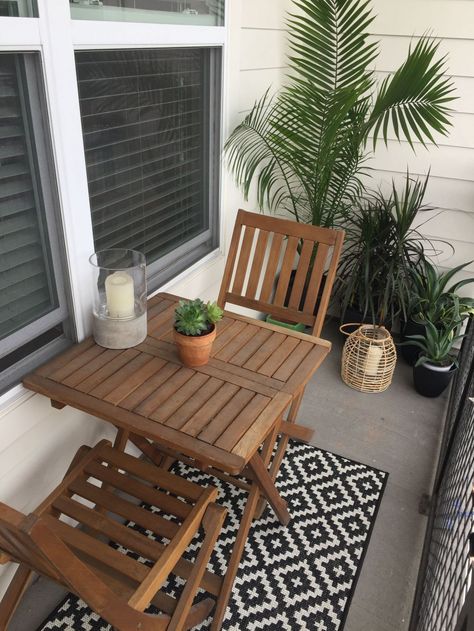
1. Start with the basics: a table and chairs. A small dining set is perfect for morning coffee, intimate dinners, cocktail hour, and quick lunchtime breaks. Go for something small and space-efficient or even furniture that can be folded up and easily leaned or stored.
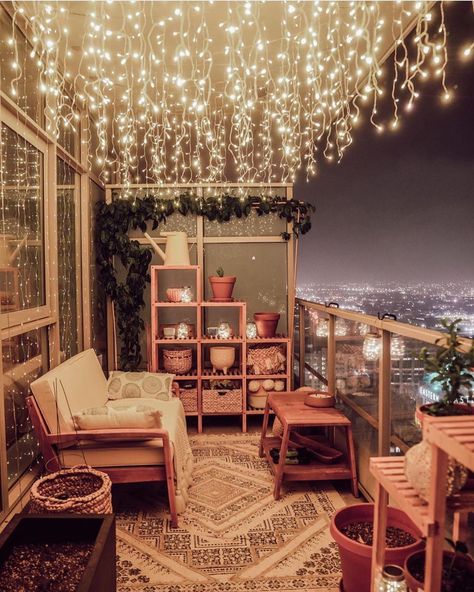
2. Showcase your view. Situate your seating or furniture so as to make the most of your view.
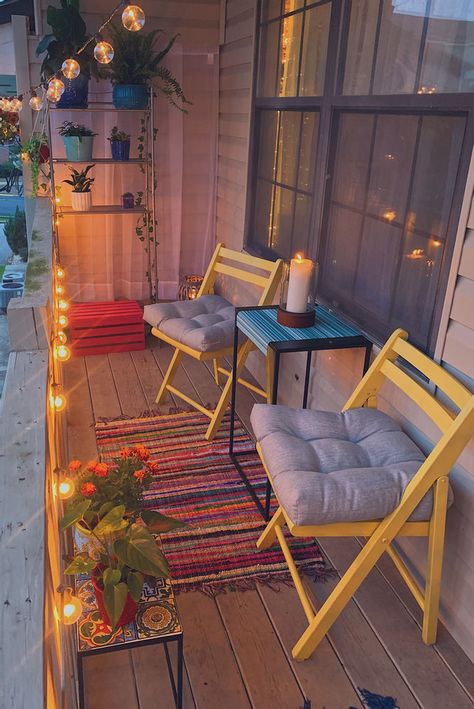
3. Use color. Color is a quick way to add personality and mood to your area. Do you want it to feel festive? Think oranges, reds, and other bright colors (look up “complementary colors” or check out Pinterest for palettes). Or would you rather make the mood quiet and relaxing? — then go with subtler, neutral, or more muted tones. You can always mix it up too, going for a muted palette but with bright accents. Get creative and make it your own!

4. Create a garden. A balcony filled with planters, climbing vines and other foliage creates a lush garden scene. You’ve got a million choices to choose from. Want plants that are fragrant, such as flowering citrus? Or ones that attract hummingbirds and pollinators? Adding herbs (cooking or decorative) will also add some lovely scents. Make sure all pots have saucers to prevent water damage.
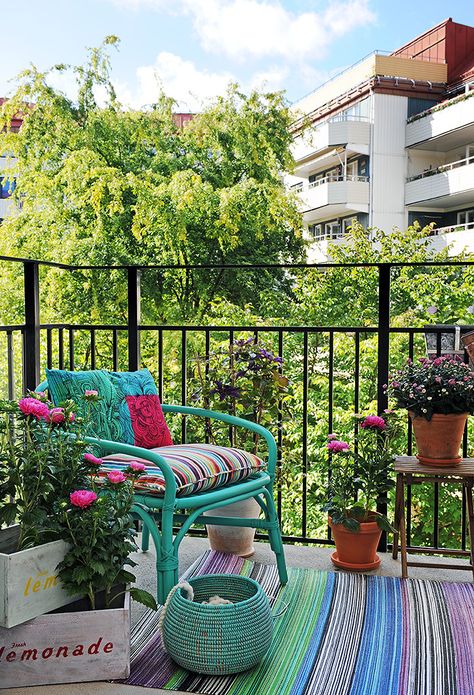
5. Add flowers for instant color appeal. Flowers and blooming plants add a sunny vibe to any balcony. Trailing blooms (think Tuscan verandas) add an extra touch of luxury.
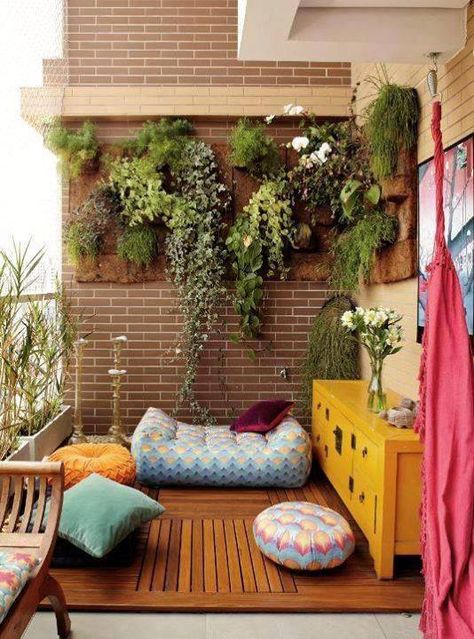
6. Check out floor pillows. If you’re on a tight budget or don’t intend to stay in your rental long, you can still dress up your outside digs. Instead of investing in furniture, look into floor pillows – usually inflatable and outdoor-friendly, these will let you enjoy your place for as long as you’re there.
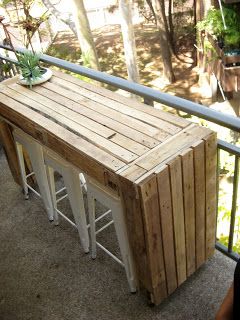
7. A place to park your drink. Remember to add little side tables or even stools to hold your book, drink, sunglasses, phone, or anything else you’ll want to set down while relaxing outside.
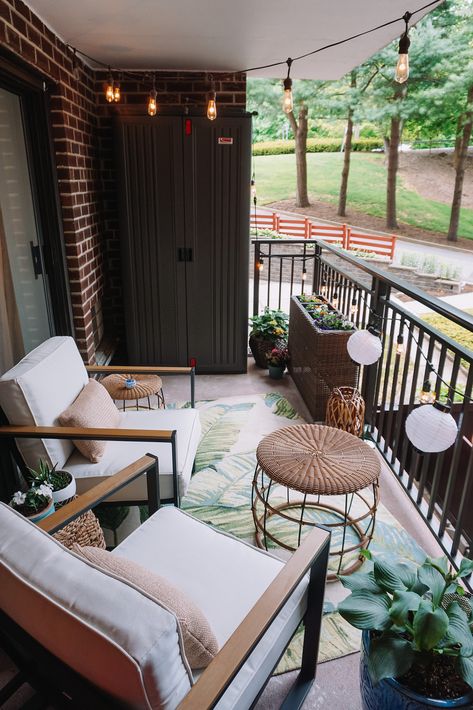
8. Throw down a rug. A patterned rug will open up the space visually and add a decorative dimension. Check out indoor/outdoor options.

9. Make an accent wall. Painting or hanging a decorative piece on the outdoor exterior walls will add a sophisticated design element. This could be an art-type piece, lights, or even a “living wall” add-on of ferns or other plants.
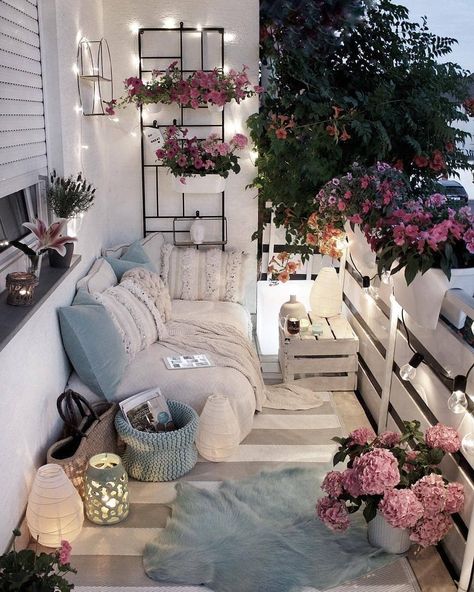
10. Add lighting. Outdoor lights will immediately up-level your balcony and give it evening ambiance. Options include strung lights (for that fairy light effect), LED candles in lanterns, and hanging or standing lights.
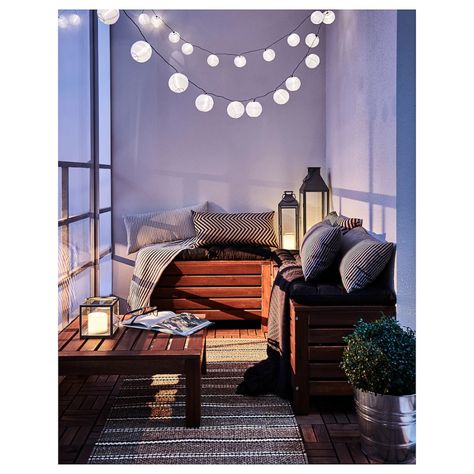
11. Consider bench seating. Bench seating is a bit more of a commitment than moveable chairs. It usually saves space and sometimes doubles as a storage element.
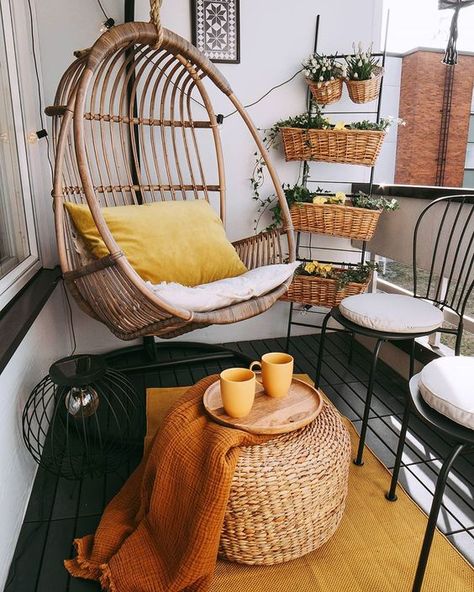
12. Hang a swing or hammock. Lazy swing-time isn’t just for vacation. If you have a lot of space, consider a hammock or swinging bench. This may even nudge you to do more of that self-care relaxing that we all know is so important!
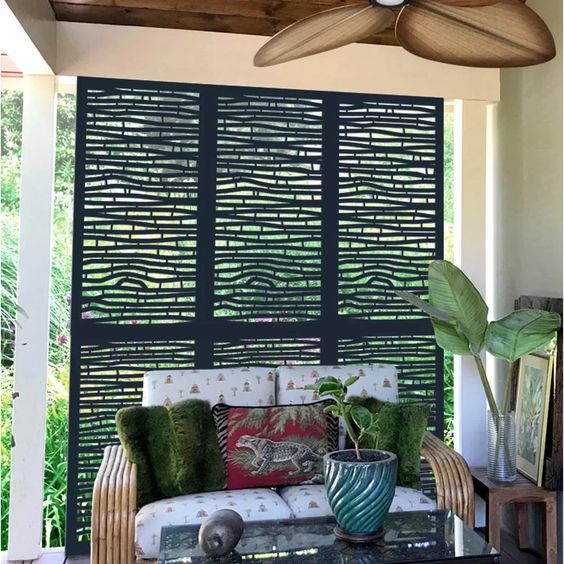
13. Create privacy. Using a room divider or a row of tall bamboo can create a nice illusion of privacy if your balcony directly abuts another.
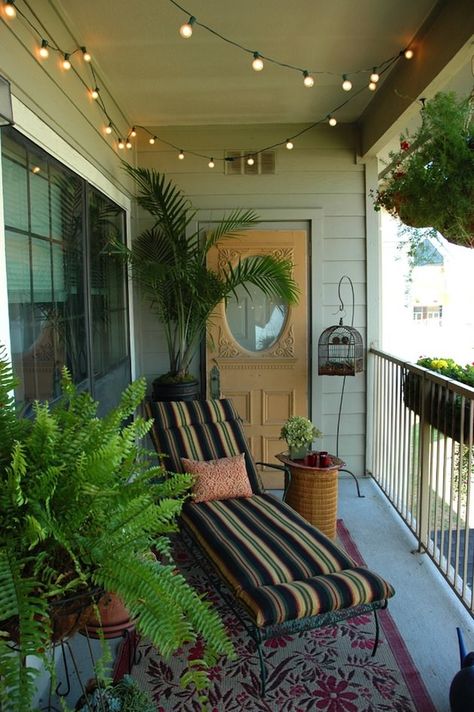
14. Go full recline mode. If space allows, think of getting a lounge chair. Perfect for curling up with a book, working on your laptop, or soaking up the sun, you can make it even comfier with outdoor pillows.

15. Throw shade. If your balcony gets a ton of light (maybe sometimes too much?), look at shading options. This could mean a standing umbrella, shade sail, or a more involved retractable awning.
Before you start on your balcony transformation project, be sure to check in with your roommate and your landlord about anything that might affect your plans. Then design around those and create your own little outdoor oasis – as spring rolls into summer and the warm weather beckons you outside, you’ll be so glad you did!
For more ideas to transform your balcony or outdoor space check out our Pinterest Board “Apartment Balcony Inspiration“
Don’t forget to give us a follow at California Casualty to stay up to date on every fun balcony inspiration we discover! Scan our Pincode with your Pinterest camera to follow:

This article is furnished by California Casualty, providing auto and home insurance to educators, law enforcement officers, firefighters, and nurses. California Casualty does not own any of the photos in this post, all are sources by to their original owners. Get a quote at 1.866.704.8614 or www.calcas.com.
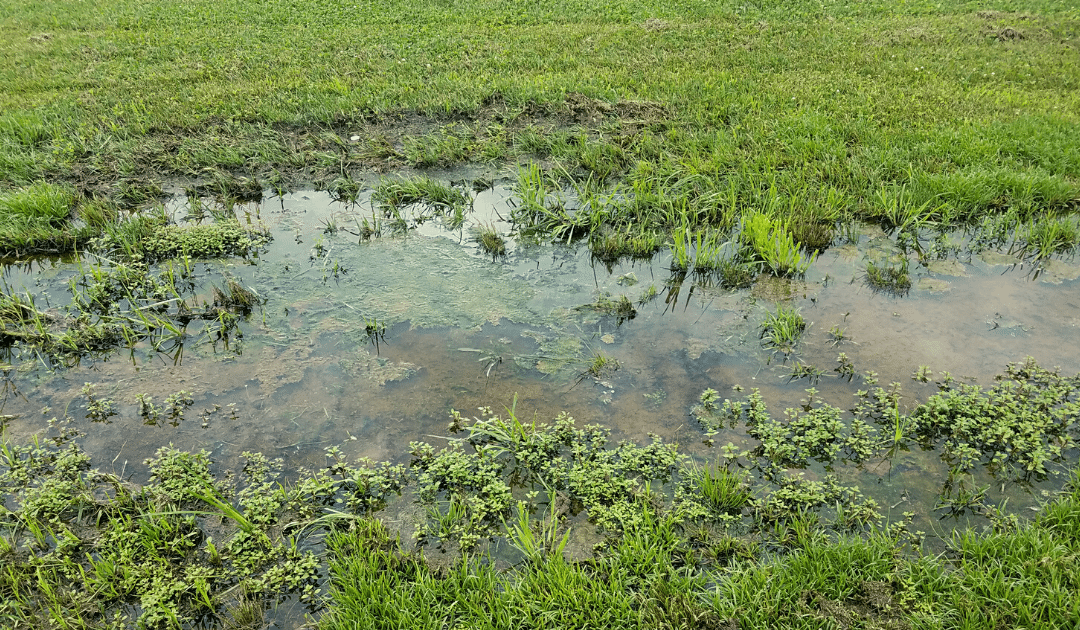
by California Casualty | Calcas Connection, Good to Know, Homeowners Insurance Info |
Spring is here! And so are spring storms, but spring showers don’t just bring flowers, they can also bring more water than what your yard can hold. And this standing water around your house can cause water damage to your home- costing you more than you think.
By definition, standing water is a body of water that does not move or sink into the ground. It can be caused by a number of factors: heavy rain, over-watering, poorly draining soil, improper grading, incorrect landscaping, low areas in your yard, and even water line leaks or bursts.
If you have standing water in your yard for multiple days, it can cause serious damage to your home. Not only will it be an eyesore that can ruin your grass and draw unwanted bugs, but stagnant water on the side of your home can also seep into small cracks or pores in your home’s foundation and get into your crawl space or basement, which can lead to water damage & more.
Here’s why you should address the standing water near your home now, and how you can prevent it from happening in the future.
Standing Water Can…
Ruin your basement. Water can cause cracks in your home’s foundation. This is how water enters your basement or your crawl space. Once inside it can create a musty odor and add dampness that will completely ruin flooring, drywall, furniture, electronics, etc.
Produce mold & mildew. High levels of condensation and humidity inside of your basement or crawl space create an environment for mold and mildew to thrive. This could not only affect your home, but it could also cause major health issues for you and your family.
Breakdown your home’s foundation. Over time, standing water that has made its way into your cement foundation will start to cause shifting and bowing of your structure. This is the beginning of the breakdown of your home’s foundation. If not taken care of- doors will no longer close, floorboards will start to squeak, steel beams may have to be inserted, and it could even lead to structural collapse.
Cost you thousands of dollars in repairs. A homeowner spends over $3,000 on average to repair damages to their home and property caused by water. Preventive maintenance and early detection are key to helping you save your home and your wallet.
But that’s not all, standing water can also draw unwanted pests: mosquitoes, roaches, termites, ants, silverfish, and other pests thrive in moist environments. They will seek damp areas and make your home their home if you don’t address the issue quickly.
Here’s how you can prevent standing water from getting into your home this spring.
How to Prevent Standing Water
1. Check for Proper Roof Drainage
Make sure every drop of rain will drain off of your roof correctly- starting at your gutters. Make sure they are free of leaves and sticks and that you have an attached downspout that is also clear of debris. It is also important to make sure your downspout has a downspout extension that will move water away from the foundation of your home.
2. Monitor Your Sprinkler Usage
If you see standing water, make sure to check that your sprinklers are not overwatering your lawn. First, check to make sure the sprinkler heads are functioning properly and not broken. If there is no issue, you will likely just need to reset your sprinklers to run at a less-frequent timespan. After resetting, if you are still seeing patches of barren or muddy lawn, you may have a leaky valve. Valves are responsible for distributing the water throughout the entire system, and if damaged they will need to be replaced right away.
3. Make Sure Your Yard is Correctly Graded
Grading, also referred to as lawn leveling, is the process of leveling your lawn to allow for the proper drainage of water. If you have water that is pooling around your foundation or your house is sitting on a low level, you may need to look into re-leveling your yard. Grading involves the moving of topsoil onto the yard. You will then even out the low spots with the soil and form a downward slope (around 2%) from your home’s foundation. Leveling is an intricate process, and if your yard needs re-leveled, you may need to hire a professional.
4. Aerate Your Lawn
Aerating your yard means to perforate the soil with holes (4 – 6 inches deep) to allow water, air, and other nutrients to better absorb into the soil. Not only will aeration lead to a greener, healthier lawn, but it will also alleviate soil compaction and allow water to better absorb during rainstorms. The best time to aerate your lawn is during spring and fall.
5. Mind Your Landscaping
Improper landscaping can cause water to sit at the base of your home’s foundation and ultimately make it into your home. When landscaping, avoid making any changes that will block drains or downspouts. Make sure that all of your landscaping slopes downward to create runoff and that all downspout extensions or drainage systems extend beyond your planting beds leading the water away and far from your foundation.
6. Install a Drainage System
If you are constantly struggling with standing water in an area of your yard, it may be best to look into installing a yard drain. Yard drains act like shower drains. They prevent flooding and move the water away from your yard through hidden pipes to a dry well. The dry well will then collect the water underground and slowly percolate to the soil around it
Standing water is a serious, yet largely overlooked, issue that can have serious consequences. If water has been in your yard for multiple days and won’t drain, don’t neglect it. Look for the cause of your problem or reach out to a professional. Acting today will save you time, money, and headache tomorrow.
This article is furnished by California Casualty, providing auto and home insurance to educators, law enforcement officers, firefighters, and nurses. Get a quote at 1.866.704.8614 or www.calcas.com.

by California Casualty | Peace Officers |
Community engagement is critical to ensuring that your police department is trusted, respected, and supported by the communities you serve. Building and maintaining positive relationships with residents, business owners and other community members help peace officers more effectively carry out their mission to serve and protect. It also helps citizens better understand emergency and public safety response and how to access help, as well as become better prepared for disasters, emergency situations, and other events affecting the whole community.
Covid has meant that engagement efforts must look different (i.e. socially distanced and with precautions) than before; however, that doesn’t mean they should stop or slow down. In fact, in times of crises like this, community engagement is more important than ever.
Here are some ideas for your agency to strengthen the bonds with your community – while keeping everyone safe.
Host virtual events
Many events that used to happen in person can be transitioned online fairly easily. Use platforms such as Zoom, GoToMeeting, Skype, Google Hangouts, or even Facebook Live from your department’s Facebook page.
-
- Community meetings – Whether a town hall or something less formal, virtual meetings allow your department to meet with your community on specific topics, questions, or concerns they may have. They also allow you to share news, announcements, and new campaigns or initiatives.
- Meet and greets – Let your neighborhoods meet their peace officers! Showing your officers’ human side – personalities, humor, and all – goes a long way toward relationship-building. This can be as simple as short self-intro videos to virtual ride-alongs in a squad car and campaigns designed for young audiences.
- Virtual tour – Offer a virtual tour of the department and its facilities – everyone loves getting a peek behind the front doors.
Connect with kids and youth
Forming good relationships with youth is key to creating a community environment where citizens can live, work and play free from fear of crime.
-
- K9 tour – Service dogs in canine units are a perennial hit with kids. You can share live videos of the dogs training with their handlers, as well as tours of their kennels and a peek inside K9 vehicles. What are the most common questions about the dogs? – answer those in your video! Check out some examples here, here, and here.
- Storytime – Make an early, positive impression on kids by reading and sharing their favorite books. Check out other departments’ videos here and here. You can customize for any age group or by topic – the possibilities are endless! Channel some Mr. Rogers, and you’ll have fans for life.
Bring it outside
With a little creativity and the proper safety precautions, your department can do many of the outdoor activities you used to, shift some previously indoor activities outside, or even start a new tradition or two.
-
- Events at the station – Depending on your station’s outdoor facilities, you can host meet and greets, K9 with kids, town halls, press briefings, and more – anything where groups can stay small and socially distanced.
- Community walks – Police chiefs like this one and this one have made a point of walking their neighborhoods as a way to meet local residents. By answering questions and learning about residents’ experiences and concerns, police leaders are able to better understand the community’s needs and challenges. These friendly one-on-one conversations also foster goodwill and help citizens feel invested.
Leverage networks
Screens, airwaves, and other virtual channels aren’t going anywhere, even when the pandemic ends. They give you a ton of options for new and sustainable ways to connect with your community.
-
- Social media – Your department’s social channels are great for 2-way communication, allowing you to push out information that you want your community to know, and also to hear directly from citizens. A simple social media strategy will help advance community outreach, problem-solving, and crime prevention efforts.
- Traditional media – Even in the digital age, “old school” media still plays an important role in helping your department spread messages, disseminate information, and raise awareness and community engagement. Build your media relationships to leverage local TV, radio, and newspapers.
Make it fun, make it meaningful – make it about them
Despite there being an end to the pandemic is on the horizon, these are still stressful times. A bit of levity can help immensely and reminds the citizens you serve that your peace officers and your department are an integral part of their community. Directly addressing the concerns, questions, and interests of your community will go a long way toward building those relationships and trust that’s paramount to your department’s success.
Support different languages
If your community is a diverse one, make sure to offer critical information in multiple languages on your virtual channels. This cuts down on information barriers and helps improve public health and safety in the entire community.
Community engagement remains one of the best ways to foster trust and respect between community members and peace officers. With a little retooling of your outreach programs, as well as some new ideas and thinking outside the box, you and your colleagues can continue building those relationships – while staying safe and keeping your community safe.
This article is furnished by California Casualty, providing auto and home insurance to educators, law enforcement officers, firefighters, and nurses. Get a quote at 1.866.704.8614 or www.calcas.com.

by California Casualty | Homeowners Insurance Info |
As the weather warms up, seasonal allergies can collide with everyday household allergens to create the perfect storm of misery for allergy sufferers. If you or your family members are allergy-prone, there are steps you can take to minimize allergens throughout your home and throughout pollen season.
These 11 tips can help vastly improve your home’s indoor air quality, helping prevent asthma flare-ups, new cases of mold allergies, and the need for bulk purchases of tissues and antihistamines!
- Clean well, clean often. A clean house is a healthier house. Regular, thorough cleaning of all surfaces and furnishings will keep allergen counts down, prevent mold and decrease pet dander. Besides the regular surfaces, keep in mind too that clearing out clutter is a big factor in controlling dust. One more reason to get rid of extra stuff!
- Vacuum regularly. Consistent vacuuming is a powerful weapon in removing allergens, toxins, mold spores, mites, and other offenders. Depending on your household’s activity levels and allergy sensitivity, you may need to vacuum as often as every other day or so. Use a HEPA filter in your vacuum and change it often.
- Control dust mites. These critters thrive in bedding and linens that aren’t cleaned often enough. Keep them in check by washing bedding, uncovered pillows, and kids’ stuffed toys in hot water each week, and dry with high heat. Zippered allergen-resistant covers for mattresses, pillows, and box springs are especially effective against allergy attacks. Avoiding heavy drapes, wall-to-wall carpet and overstuffed fabric furniture also control mites, as does humidity-regulating air-conditioning.
- Limit indoor greenery. House plants add beauty, but many times they can harbor mold. Try to cull out all but your favorites, and for the plants you do keep, lay down aquarium gravel on top of the soil to discourage mold growth.
- Get an air filter or purifier. Air cleaning devices can significantly improve indoor air quality (if you’re on the west coast, these are a lifesaver during wildfire season). Go for high-quality air filters such as HEPA or certified asthma/allergy ones. Choose from stand-alone filters or those designed to be installed in your central air system – or better yet, both!
- Stay ahead of pet dander. Keeping up with a vacuuming and cleaning schedule will help limit dander. You can also cover vents with material such as cheesecloth to catch circulating dander. Regularly wash and dry pet beds and toys. Bathe pets weekly and wear a mask when grooming them. And finally, if you’re able to resist the puppy-dog eyes, try not to let pets sleep in bedrooms.
- Keep pollen out. Keep doors and windows closed and use the air conditioning to keep pollen, dust, and other toxins outside. Change air filters frequently, especially during pollen season.
- Prevent mold. Damp areas breed mold spores, which then travel throughout your home. Reduce moisture in the bathroom by running a fan during and after showers, minimizing shower time, and making sure wet clothes, towels, and bathing suits are hung or dried. To further limit the spread of mold, use dehumidifiers and/or air conditioning, use humidity monitors if needed, limit the number of houseplants and fix all leaks.
- Control pests. Prevent cockroaches and mice with traps or hire a professional exterminator. Repel them in the first place by always putting garbage, food waste, and recycling into containers with an insect-proof lid and emptying bins daily. Keep the kitchen free of crumbs and food scraps. Store pet food in sealed containers. Seal cracks and other possible pest entryways.
- Dehumidify. Use a dehumidifier in especially damp areas such as the basement.
- Adopt a no-smoking policy. Do not allow smoking inside your home. Besides a range of serious health effects, tobacco smoke can also cause asthma – not just for the smoker but for anyone exposed to secondhand smoke.
The bad news about allergies? They will always be around us. The good news? We can do something about them! A thorough spring cleaning can get you on the right track (not sure where to start? – check out our tips here!). After that, consistently following the 11 steps above will help reduce allergens and improve your indoor air quality all year round – which will in turn keep you and your family healthier and safer for years to come.
This article is furnished by California Casualty, providing auto and home insurance to educators, law enforcement officers, firefighters, and nurses. Get a quote at 1.866.704.8614 or www.calcas.com.





















